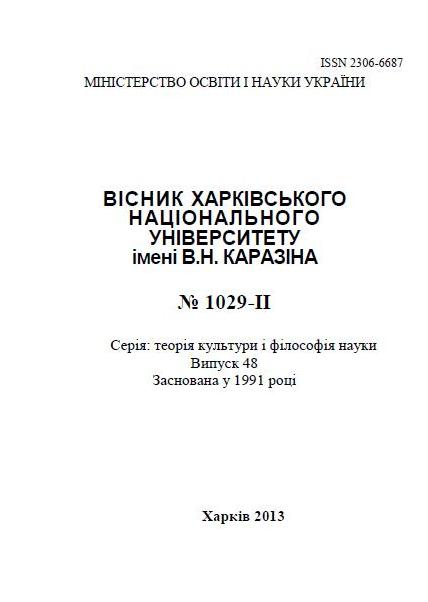ЖЕНСКИЕ ОБРАЗЫ В ЖИВОПИСИ РУССКИХ И ФРАНЦУЗСКИХ ОРИЕНТАЛИСТОВ: ФИЛОСОФСКО-АНТРОПОЛОГИЧЕСКИЙ АНАЛИЗ
Анотація
В статье представлены Case studies: на примере трех произведений живописи
французского и русского ориентализма XIX века исследуется семантика «Востока»
через репрезентации образов восточной женщины. Цель исследования –
проанализировать эволюцию идеологии ориентализма в культурном сознании. Новизна
обусловлена применением постмодернистского и гендерного анализа к образцам
классической живописи, что позволяет определить специфику диалога «Восток – Запад»
с позиций властных и гендерно-расовых иерархий.
Суковата В.А., Фісун К.Г. ЖІНОЧІ ОБРАЗИ РОСІЙСЬКИХ І ФРАНЦУЗСЬКИХ
ОРІЄНТАЛІСТІВ: ФІЛОСОФСЬКО-АНТРОПОЛОГІЧНИЙ АНАЛІЗ У статті
представлені Case studies: на прикладі трьох творів живопису французького та
російського орієнталізму XIX століття досліджується семантика «Сходу» через
репрезентації образів східної жінки. Мета дослідження - проаналізувати еволюцію
ідеології орієнталізму в культурній свідомості. Новизна обумовлена застосуванням
постмодерністського та гендерного аналізу до зразків класичного живопису, що дозволяє
визначити специфіку діалогу «Схід - Захід» з позицій владних і гендерно-расових ієрархій.
Ключові слова: жіночність, орієнталізм, сексуальність, постколоніальна критика,
діалог «Схід - Захід», «глядацький погляд», гендерний аналіз.
Sukovataya V. Fisun K. THE WOMEN’S IMAGES IN THE PAINTINGS OF RUSSIAN
AND FRENCH ORIENTALISTS: THE PHILOSOPHICAL AND ANTHROPOLOGICAL
ANALYSIS The paper presents the Case studies: the semantics of "East" was studied through the
representations of images of the Eastern woman on material of the three samples of paintings of
French and Russian Orientalism of the 19th century (on material of the works by J.A.D. Ingres,
E. Delacroix, V. Vereschagin).
The purpose of the study is to analyze the evolution of the ideology of Orientalism in the
cultural consciousness of the 19th century in the context of the gender and postcolonial critique.
The tasks are: putting the postmodernist and feminist methodologies into visual arts history
practices, the comparative analyses of the national specifics of the Russian and French
Orientalism, analyses of the constructions of the femininity in the European colonial
imagination. The methodological base of research is works by E. Said, J.-P. Sartre, L. Mulvey,
M. Foucault, G. Spivak.
Actuality of the research is stipulated by necessity to study the relationship between
gender and race in the Orientalist painting of the 19th century, to consider the image of "East"
(“Orient”) in the context of the cultural notions on femininity and gender subordination. The
novelty is due to the using of postmodernist and gender analysis to classical painting, which
allows to identify the specifics of the dialogue "East - West" from positions of power and genderracial
hierarchies.
There was examined the status of the Eastern (“colored”) woman in the French imperial
consciousness of the 19th century in comparison with European (”white”) throught the images of
the “oriental” sexuality and gender subordination. It was proving that semantics of “East” in
the Western European colonial mentality is connected with “femininity”, “wildness”,
“debauchery”, “exoticism” and the relations of the "East-West" are reflected as opposition
civilized, rational and cultural European "the I” and the secretive, unpredictable, coarse,
indecent, irrational “Other". The goal of this hieratchical opposition to make a significant
moral distance between the European subject and the Eastern Other to justify the West
European colonial invasion in the view of own public opinion and to create a cultural
legitimation of the French colonial policy. So, femininity and gender status played an important
role in the Orientalism consciousness: if the West personified the image of "men", "center",
"hegemony", “authority”, the East logically reproduced a metaphor of "woman", "marginality",
"deviance" and "dependence". The “Eastern body” was constructed as a “non-normative body”
in comparison with “European norms” of women’s behavior and a living space. That is why a
harem is the favorite place to present the Eastern woman in the European orientalist painting.
This ideological subordination was discovered by the authors of this paper in the French
orientalist painting: on one hand, a “spectator’s look” reflected the masculine point of view in
which a woman presented as an object of observation and control. On other hand, the
spectator’s look in the most well-known works by the Orientalism painting is coincided with the
“imperial gaze”, the position of a masculine, white, heterosexual dominated man.
There was evolution of Orientalism ideology: if J.A.D. Ingres pictured the Eastern
woman as a colorful and tempting exoticism; E. Delacroix constructed the Eastern female
images as a metaphor of a sexual accessible French woman; V. Vereshchagin created a type of
a "oppressed" Eastern women and he implicitly condemning so cruel colonial policies. To sum
up that the evolution of European Orientalism was dependent on what type of identity –
“hegemonic” or “colonial” – a painter as a subject sympathized with.
Keywords: femininity, Orientalism, sexuality, postcolonial criticism, dialogue "East -
West", "spectator’s look", gender analysis.




